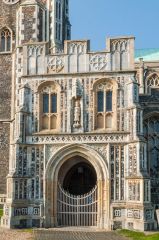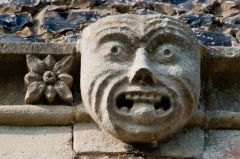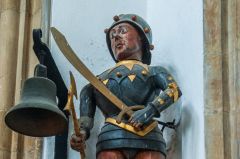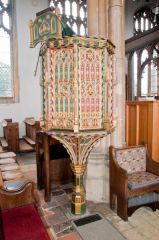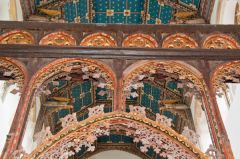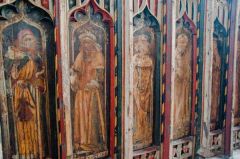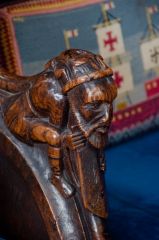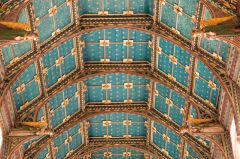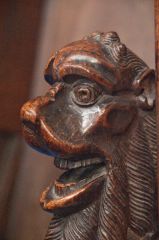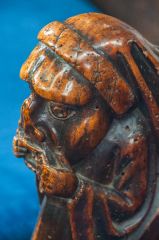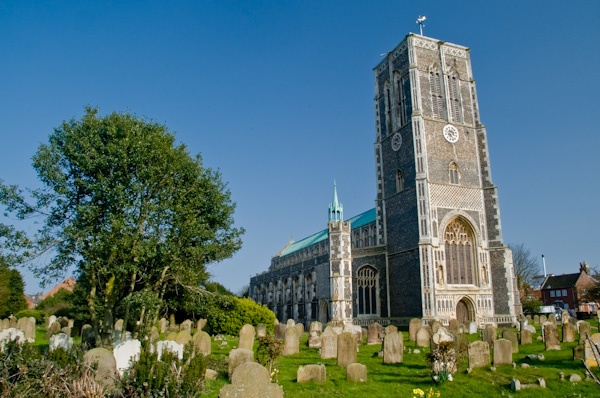
Visitors to Southwold usually come for the amusement pier, or just to take in the sea air and have a family day out on the beach. At first glance, you wouldn't think that this attractive seaside town has much of historic interest, but you'd be wrong.
Long before Southwold became a popular seaside resort it was a quiet fishing hamlet, served by a small 13th-century church. Over the following century, however, Southwold grew into a bustling town, fuelled by the burgeoning Suffolk wool trade.
In 1430 that church was destroyed by fire, and a new church begun, funded by the wealth of local wool merchants. The church was built in one go, and took about 60 years to complete. Because it was built in one concerted effort rather than gradually enlarged over time, it is an excellent example of 15th-century architecture.
St Edmunds has been called the finest church in Suffolk - a bold claim for a county blessed with so many superb medieval churches, but a reflection of just how rich and influential Southwold wool merchants had become by the middle of the 15th century.
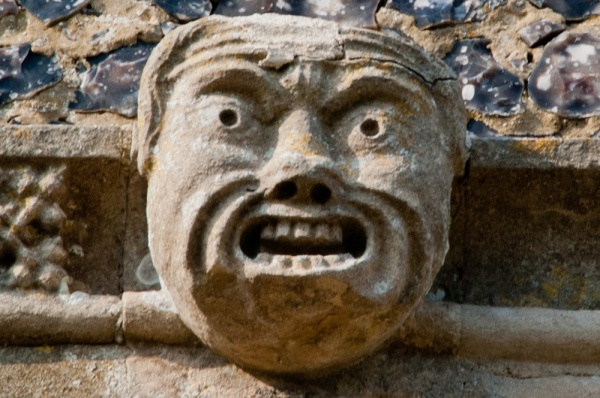
The most impressive part of the church exterior is the two-storey south porch, with a large parvise chamber over the arched entrance. Along the line of the nave roof are a frieze of grotesque figures, each with a unique expression. The porch and west tower are superb examples of East Anglian flushwork; napped and unknapped pieces of flint arranged to create intricate designs. Over the west window, the flint is arranged to spell out the Latin phrase SCT. EDMUND ORA P. NOBIS (St Edmund pray for us).
Rose Rent
The sheer scale of the new 15th-century church required more land than the previous 13th-century building. That land was obtained from the Prior of Thetford, who gave a plot of land for the churchyard. He did not ask for payment, but requested that a single rose be placed on the high altar on St John the Baptist's feast day, 24 June. The 'rose rent' is still paid today, and each 24th June a rose is placed with ceremony on the altar to acknowledge the debt.
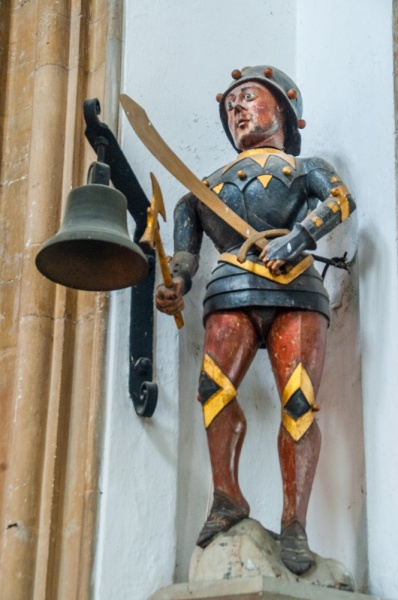
Southwold Jack
The most famous historical feature of Southwold's church is a 15th-century mechanical figure called 'Jack of the Clock' or Southwold Jack', made to strike the hour bell but now mounted on a nave pier beside a small bell on a projecting bracket. Southwold Jack is dressed in the armour of a soldier during the Wars of the Roses, with an axe in one hand and a sword in the other. The axe rises and falls to strike a bell, warning the congregation that service is about to commence.
Such mechanical figures are very rare, though another exists at nearby Holy Trinity church in Blythburgh. Southwold Jack has been adopted by Adnams Brewery as their trademark symbol.
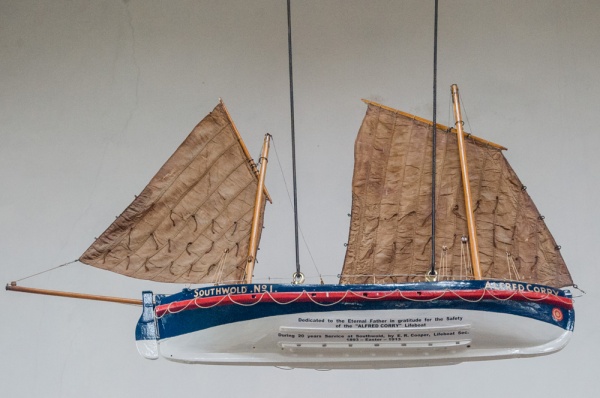
The Lifeboat Model
Hanging from the nave ceiling is a replica of the Alfred Corry, built in 1893 and Southwold's lifeboat for 25 years until 1918. During 25 years of service, the boat was launched 41 times and saved 47 lives. In the churchyard is the grave of the Alred Corry's coxswain, Sam May.
May's gravestone bears the epitaph:
His anchor was the holy word
His rudder blooming hope
The love of God his main topsail
And faith his sailing rope.
The restored lifeboat can be seen in the Old Cromer Lifeboat Shed in the car park on Ferry Road.
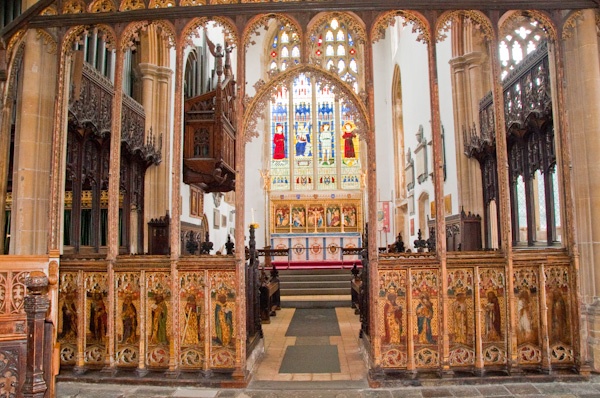
The Rood Screen
One of the delights of St Edmund's church is the remarkable 15th-century screen, erected around 1480 and stretching across the entire width of the church. Though the tracery at the top of the screen was damaged by Puritans and the painted figures of the twelve apostles on the screen base were defaced it is still a remarkable medieval treasure. Though the faces are obliterated you can still see the saint's symbols so each figure can be identified.
Though the screen escaped the worst efforts of William Dowsing and his band of iconoclasts in 1643 the same cannot be said for the church's medieval glass. All the glass was destroyed, and today only modern clear glass remains, save for the east window and the west tower window. Even the Victorian glass was destroyed in a WWII bomb blast.
Chancel Bench Ends
The chancel boasts some extremely good 15th-century carved bench ends on the choir stalls. One bench end shows a man with his mouth open, thought to depict the agony of toothache.
One historic oddity that you can't immediately see is an unusual acoustic chamber in the floor beneath the choir stalls. This chamber was dug to amplify the sound of the church choir. The choirmaster must have experimented with different ways to improve the acoustics, for church records show that various objects were installed in the acoustic chamber to amplify the sound further, including empty pots and horses skulls.
Other interior highlights include a stunning font cover, reaching 20 feet high and delicately carved like an ornate steeple. The medieval wineglass pulpit is richly gilded and painted. The east window was designed by Sir Ninian Comper and depicts St Edmund. The window was installed in 1954.
There is an amusing tale about St Edmund's from the late 19th century. It seems that the church was falling into decay, and the church roof, in particular, was in a very poor state. An investigation found that a large piece of the roof, directly over the pulpit, was in imminent danger of collapse.
Unfortunately, the roof was so high over the nave that to reach the dangerous piece of roofing was extremely difficult. A solution was at hand, however, when a member of the local cricket team was called in to dislodge the rotten piece of roofing with a cricket ball. He must have been successful, for no further mention is made in the church records of the dangerous piece of rotten roofing.
The church is usually open daily to visitors and was open when we visited - though we did have to wait briefly for a service to end.
About Southwold, St Edmund's Church
Address: Bartholomew Green,
Southwold,
Suffolk,
England, IP18 6JA
Attraction Type: Historic Church
Location: Just off Victoria Street. Easy access from the A1095/High Street and North Parade
Website: Southwold, St Edmund's Church
Location
map
OS: TM507763
Photo Credit: David Ross and Britain Express
POPULAR POSTS
HERITAGE
 We've 'tagged' this attraction information to help you find related historic attractions and learn more about major time periods mentioned.
We've 'tagged' this attraction information to help you find related historic attractions and learn more about major time periods mentioned.
Find other attractions tagged with:
NEARBY HISTORIC ATTRACTIONS
Heritage Rated from 1- 5 (low to exceptional) on historic interest
Walberswick, St Andrew's Church - 1.5 miles (Historic Church) ![]()
Covehithe, St Andrew's Church - 3.5 miles (Historic Church) ![]()
Blythburgh, Holy Trinity Church - 3.6 miles (Historic Church) ![]()
Dunwich Leper Chapel - 4.1 miles (Historic Church) ![]()
Dunwich Greyfriars - 4.1 miles (Abbey) ![]()
Wenhaston, St Peter's Church - 5.1 miles (Historic Church) ![]()
Blyford, All Saints Church - 5.1 miles (Historic Church) ![]()
Thorington, St Peter's Church - 5.4 miles (Historic Church) ![]()
Nearest Holiday Cottages to Southwold, St Edmund's Church:
More self catering near Southwold, St Edmund's Church
